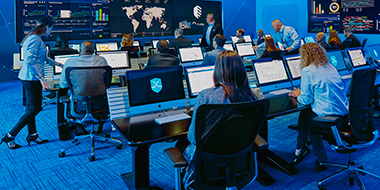Perspectives
AI and the Changing Nature of Work
11 January, 2024 | Written by: Jon Lester
Categorized: Artificial Intelligence | Perspectives
Share this post:
As companies look ahead to 2024, we can be confident that deploying AI will be high on the business agenda. For those business leaders looking to harness AI to boost productivity, one critical area to explore should be AI in the workplace.
The use of AI and machine learning in the workplace is not particularly novel – for years, businesses have been using it for very specific tasks. What is exciting now is how generative AI is increasing capabilities, providing the opportunity for us to harness augmented intelligence to modernise processes and transform back-office roles.
A new hybrid workforce
The growing sophistication of digital assistants is one prime of example of how generative AI can benefit your workforce. While automated ‘chat-bots’ have been around for years, the large language processing capabilities of generative AI is transforming their useability and capability to create an application more akin to a ‘digital worker’ than a bot.
At IBM, we have been doing just this; deploying initially basic but more recently more complex generative AI to reduce the administrative burden on the HR Support desk and freeing up our employees to focus on higher value work.
This shift is transforming the work of our HR team. In 2016, 1.6 million queries were raised by our workforce related to issues across pay, pension, and company policies, each one requiring attention from HR. The development of our digital assistant, trained in secure data across the company, was able to transform this admin-heavy FAQ task, providing accurate responses to employees’ questions.
By adding intelligence automation within the department, we have also been able to advance this support, creating an application that supports employees through a series of related tasks and events, fundamentally changing the way you get work done.
For example, IBM WatsonX Orchestrate Digital Workers are assisting HR teams and IBM employees through lengthy and complex internal data collection processes which are part of virtual classroom management, travel audit or promotions. These processes can be incredibly time consuming and disjointed in businesses, necessitating data from many different sources, multiple times. The presence of this AI ‘digital worker’ enables a new type of ‘hybrid workforce’ and ensures that employees can focus on the decision-making element of their role, not the data collection.
Demonstrating its worth
As AI is increasingly used to automate administrative tasks, certain work and tasks will disappear. But these will open the door for new roles and skills, ultimately allowing workers to move onto higher value work.
The ‘high-value work’ argument has been regularly cited as one benefit of generative AI, but until now, the argument has been lacking in real evidence.
However, at IBM we now have the tangible proof to show the lift of value work our HR employees have experienced since the introduction of AI and Automation. This not only includes the freedom to focus on decision-making and human-centric tasks but through the expansion of their responsibilities into new areas, such as data science, prompt engineering, and management of digital assistants, resulting in tangible career and pay benefits.
At IBM, we strongly believe that this ‘hybrid workforce’ is the future of work – with AI assisting humans and allowing them to do fulfilling high value work and expand their skillset to align with the macro-shifts taking place in our job markets and economies.
Ethics and People
When we discuss AI in the workplace, it is important for business leaders to remember that the two biggest assets of a company are its people and its data. Technology is an enabler, but its success its dependent on the data it is built upon, the people who use it and how they do so.
Crucially, the effective use of both these assets relies heavily on trust.
Trusted, clean datasets are the foundation of any successful AI strategy. It is critical that companies build strong governance frameworks that are rooted in ethical principles, addressing the tenets of transparency, explainability, fairness, privacy and robustness.
Achieving this will require continuous human oversight. AI must never make decisions about humans, and ensuring humans are always kept in the loop will mitigate against bias and assist in improved model development.
Trust will also be generated within your teams by making AI deployment a collaborative process. Listening to employee advice and feedback on where efficiencies can be made and where AI can best support their jobs can help companies decide where AI investment should be directed to achieve the best ROI possible.
A recent IBM Study, Responsible Leadership in the age of AI, found that 96% of business leaders across Europe are prioritising governance and ethics in their deployment of AI. It is encouraging that business leaders understand what is at stake and are approaching AI deployment with the due diligence and ethical consideration it necessitates.
The regulatory landscape
Businesses seeking to deploy AI in their workforce must also remain educated and engaged with the shifting regulatory landscape.
Policy makers across the EU, UK and US are starting to provide a solid framework around the use of AI, evident in the discussions at the UK AI Safety Summit in the UK in November and the progression of the EU AI Act.
Going forward, it will be important that policy makers devise risk-based approaches, regulating specific use-cases of AI rather than the technology itself. This is important to allow best use of the capabilities of the underlying technologies. Policy makers should also emphasise the value of responsible AI governance by encouraging adherence to principles such as education on AI ethics, transparency to the end-user, mitigation of bias and data security.
Overall, policy makers across the world should facilitate ethical use of AI in the workforce whilst enabling innovative uses of AI to help employees improve the way they do their work. To achieve this, they must be working with business leaders themselves to understand the landscape, current business challenges, and where AI can drive productivity.
Conclusions
Generative AI is predicted to add between $2.7 trillion – $4.4 trillion annually to the global economy. It has the power to transform roles and boost performance across a host of business functions, from sales, to HR and customer services. Companies need to be investing in their workforces now, ensuring that workers across the regions are benefitting from technology, and have access to the skills and tools required to thrive in the fast-changing economic landscape.

Vice President HR Technology, Data & AI
The Six Reasons Why Apprenticeships Mean Business
As a passionate champion of apprenticeships, I’m delighted to see the model growing in popularity and reputation. UCAS, for example, now features apprenticeships on their website on a par with traditional university opportunities. Despite this, however, I’m often still asked “can we have a graduate for our business?”. To which I reply: “how about an […]
Will GenAI bring us greater operational agility?
It has been quite an exciting summer for tech in government, with the buzz around Generative AI rippling across Whitehall. 80% of all public and private sector organisations will have incorporated AI into their business processes during the next three years. GenAI raises some interesting questions about whether the public sector can effectively use it […]
Unlocking the power of data with artificial intelligence to accelerate innovation
Unlocking the power of data with artificial intelligence to accelerate innovation Data is the lifeblood of business – it drives innovation and enhances competitiveness. However, its importance was brought to the fore by the pandemic as lockdowns and social distancing drove digital transformation like never before. Forward-thinking businesses have started to grasp the importance of […]


